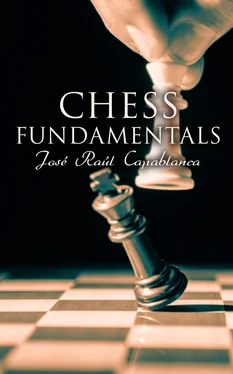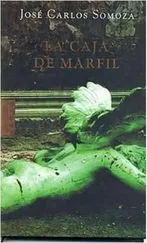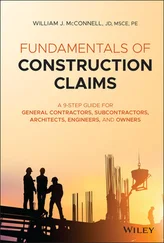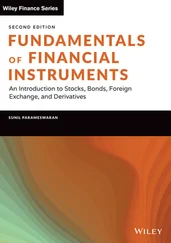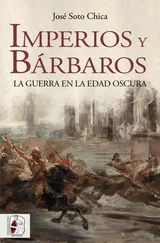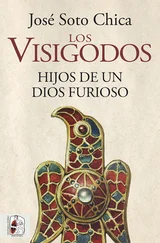Example 9.—In this ending
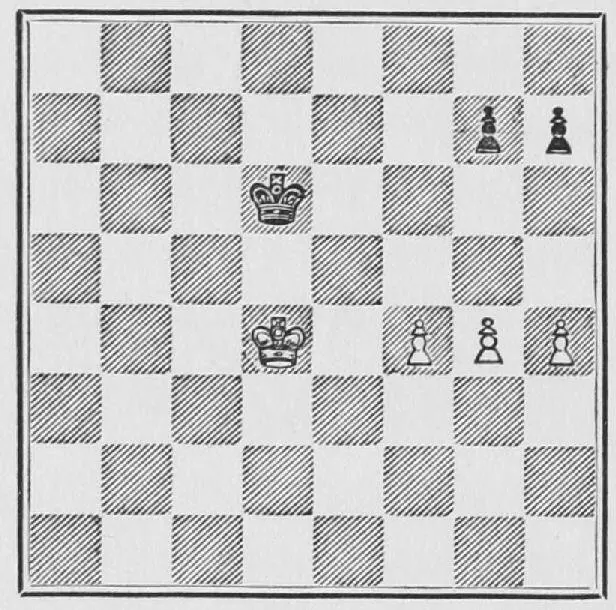
White can win by advancing any of the three Pawns on the first move, but it is convenient to follow the general rule, whenever there is no good reason against it, of advancing the Pawn that has no Pawn opposing it . Thus we begin by—
1. P - B 5, K - K 2.
If P - Kt 3, P - B 6; and we have a similar ending to one of those shown above. If 1...P - R 3; 2 P - Kt 5.
2. K - K 5, K - B 2; 3. P - Kt 5, K - K 2.
If 3...P - Kt 3; 4 P - B 6, and if 3...P - R 3; 4 P - Kt 6 ch, and in either case we have a similar ending to one of those already shown.
4. P - R 5,
and by following it up with P - Kt 6 we have the same ending previously shown. Should Black play 4...P - Kt 3, then R P × P, P × P; P - B 6 ch with the same result.
Having now seen the cases when the Pawns are all on one side of the board we shall now examine a case when there are Pawns on both sides of the board.
Example 10.—In these cases the general rule is to act immediately on the side where you have the superior forces . Thus we have:
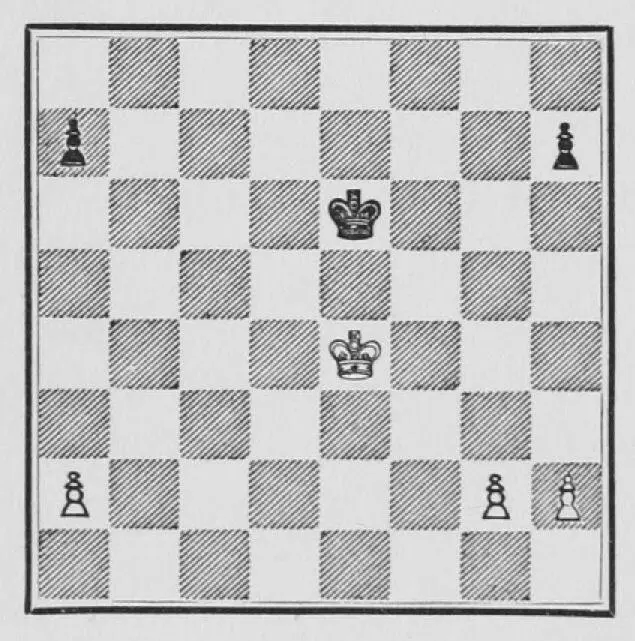
1. P - K Kt 4.
It is generally advisable to advance the Pawn that is free from opposition.
Black makes an advance on the other side, and now White considers whether or not he should stop the advance. In this case either way wins, but generally the advance should be stopped when the opposing King is far away.
2. P - Q R 4, K - B 3; 3. P - R 4, K - K 3.
If 3...K - Kt 3, then simple counting will show that White goes to the other side with his King, wins the P at Q R 4, and then Queens his single Pawn long before Black can do the same.
4. P - Kt 5, K - B 2; 5. K - B 5, K - Kt 2; 6. P - R 5, K - B 2.
If 6...P - R 3; 7 P - Kt 6, and then the two Pawns defend themselves and White can go to the other side with his King, to win the other Pawn.
7. K - K 5.
Now it is time to go to the other side with the King, win the Black Pawn and Queen the single Pawn. This is typical of all such endings and should be worked out by the student in this case and in similar cases which he can put up.
4. SOME WINNING POSITIONS IN THE MIDDLE-GAME
By the time the student has digested all that has been previously explained, he, no doubt, is anxious to get to the actual game and play with all the pieces. However, before considering the openings, we shall devote a little time to some combinations that often arise during the game, and which will give the reader some idea of the beauty of the game, once he becomes better acquainted with it.
Example 11.
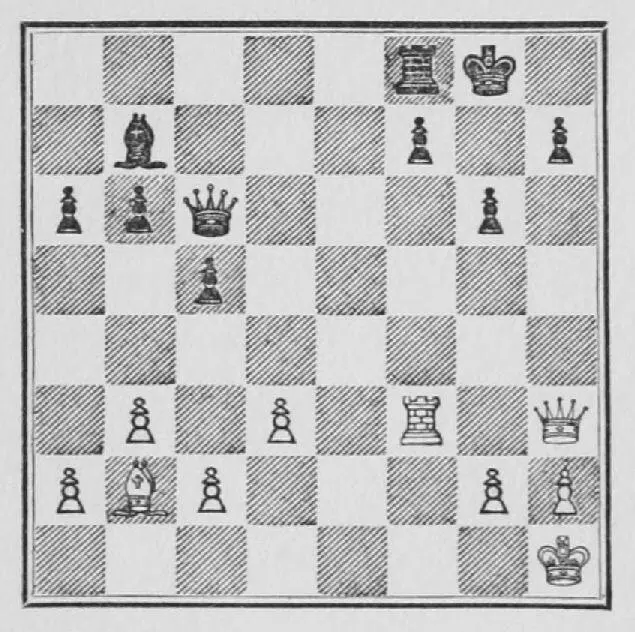
It is Black's move, and thinking that White merely threatens to play Q - R 6 and to mate at K Kt 7, Black plays 1 ... R - K 1, threatening mate by way of R - K 8. White now uncovers his real and most effective threat, viz.:
1 ... R - K 1; 2 Q × P ch, K × Q; 3 R - R 3 ch, K - Kt 1; 4 R - R 8 mate.
This same type of combination may come as the result of a somewhat more complicated position.
Example 12.

White is a piece behind, and unless he can win it back quickly he will lose; he therefore plays:
He cannot take the Kt because White threatens mate by Q × P ch followed by R - R 3 ch.
Again if B × Kt; Q × P ch, K × Q; R - R 3 ch, King moves; R - R 8 mate.
|
3. R × Q |
B × R |
|
4. Q - Q 7 |
|
and White wins one of the two Bishops, remains with a Q and a B against a R and B, and should therefore win easily. These two examples show the danger of advancing the K Kt P one square, after having Castled on that side.
Example 13.
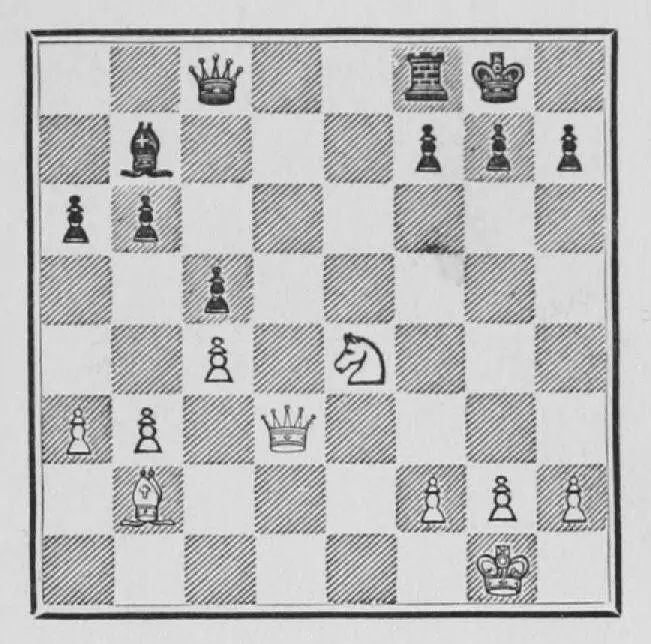
This is another very interesting type of combination. Black has a R for a Kt and should therefore win, unless White is able to obtain some compensation immediately. White, in fact, mates in a few moves thus:
Forced, otherwise Q X P mates.
|
2. Q - Kt 3 ch |
K - R 1 |
|
3. B × P mate. |
|
Example 14.—The same type of combination occurs in a more complicated form in the following position.
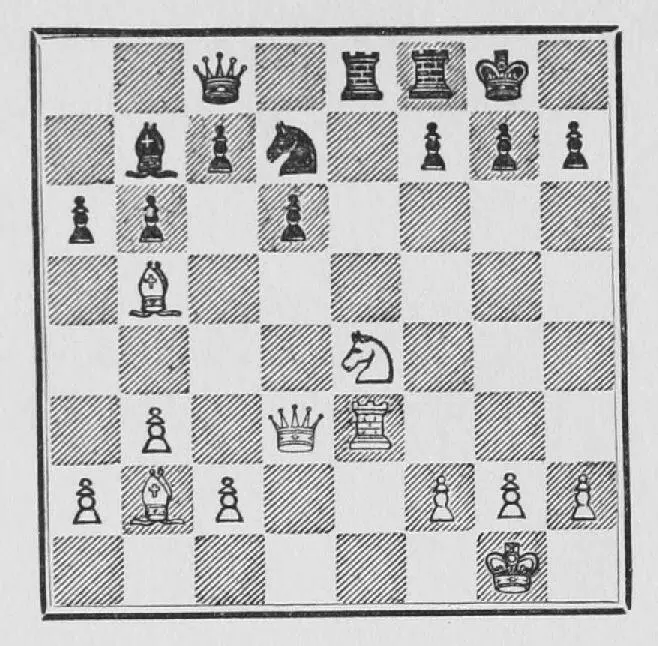
If ...B × Kt; Q - B 3 threatens mate, and therefore wins the Q, which is already attacked.
|
2. Kt - B 6 ch |
P × Kt |
|
3. R - Kt 3 ch |
K - R 1 |
|
4. B × P mate. |
|
Example 15.—A very frequent type of combination is shown in the following position.

Here White is the exchange and a Pawn behind, but he can win quickly thus: 1 B × P ch, K × B. (If 1...K - R 1; 2 Q - K R 5, P - K Kt 3; 3 Q - R 6, and wins.)
2 Q - R 5 ch, K - Kt 1; 3 Kt - Kt 5, and Black cannot stop mate at K R 7 except by sacrificing the Queen by Q - K 5, which would leave White with a Q for a R.
Example 16.—This same type of combination is seen in a more complicated form in the following position.
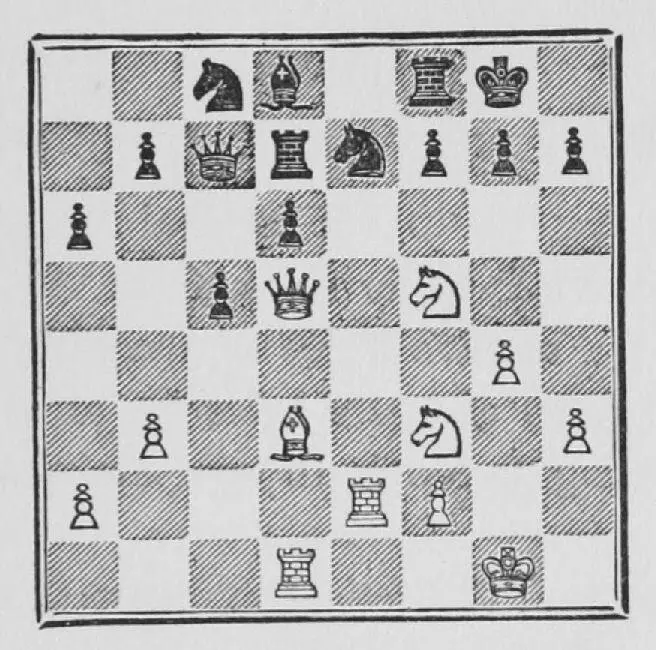
White proceeds as follows: 1 Kt × Kt ch (this clears the line for the B); B × Kt (to stop the Kt from moving to Kt 5 after the sacrifice of the B); 2 R × B, Kt × R best; 3 B × P ch, K × B. (If 3..K - R 1; 4 Q - R 5, P - K Kt 3; 5 B × P ch, K - Kt 2; 6 Q - R 7 ch, K - B 3; 7 P - Kt 5 ch, K - K 3; 8 B × P ch, R × B; 9 Q - K 4 mate.) 4 Q - R 5 ch, K - Kt 1; 5 Kt - Kt 5, R - B 1; 6 Q - R 7 ch, K - B 1; 7 Q - R 8 ch, Kt - Kt 1; 8 Kt - R 7 ch, K - K 2; 9 R - K 1 ch, K - Q 1; 10 Q × Kt mate.
This combination is rather long and has many variations, therefore a beginner will hardly be able to fathom it; but, knowing the type of combination, he might under similar circumstances undertake and carry out a brilliant attack which he would otherwise never think of. It will be seen that all the combinations shown have for a foundation the proper co-ordination of the pieces, which have all been brought to bear against a weak point.
Читать дальше
